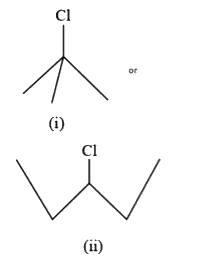Which of the following set of statements regarding the SN1 reaction shown by alkyl halide is correct here?
1. the SN1 reaction on the chiral starting material end up with racemization of the product
2. The more stable the carbocation intermediate the faster the SN1 reaction .
3. The added nucleophile plays no kinetic role in SN1 reaction
4. The SN1 reaction involves the inversion of configuration of the optically active substrate
1,2
2,3
1,3
1,2,3
The correct Answer is:D
To solve the question regarding the SN1 reaction shown by alkyl halides, we will analyze each of the statements provided.
1. Understanding the SN1 Mechanism:
- The SN1 (Substitution Nucleophilic Unimolecular) reaction involves two main steps:
- Formation of a carbocation intermediate after the leaving group departs.
- Nucleophilic attack on the carbocation.
2. Analyzing Statement 1:
- Statement: The SN1 reaction on the chiral starting material ends up with racemization of the product.
- Explanation: When a chiral alkyl halide undergoes an SN1 reaction, the planar carbocation can be attacked by the nucleophile from either side, leading to a mixture of both enantiomers (racemization).
- Conclusion: This statement is correct.
3. Analyzing Statement 2:
- Statement: The more stable the carbocation intermediate, the faster the SN1 reaction.
- Explanation: The rate of an SN1 reaction is directly related to the stability of the carbocation formed. Tertiary carbocations are more stable than secondary, which are more stable than primary. Thus, a more stable carbocation leads to a faster reaction.
- Conclusion: This statement is correct.
4. Analyzing Statement 3:
- Statement: The added nucleophile plays no kinetic role in SN1 reaction.
- Explanation: In an SN1 reaction, the rate-determining step is the formation of the carbocation, which depends solely on the concentration of the alkyl halide. The nucleophile's concentration does not affect the rate, as it attacks after the carbocation is formed.
- Conclusion: This statement is correct.
5. Analyzing Statement 4:
- Statement: The SN1 reaction involves the inversion of configuration of the optically active substrate.
- Explanation: Inversion of configuration is characteristic of SN2 reactions, not SN1. In SN1, due to the formation of a planar carbocation, the nucleophile can attack from either side, leading to racemization rather than strict inversion.
- Conclusion: This statement is incorrect.
Final Answer:
The correct statements regarding the SN1 reaction are:
1. The SN1 reaction on the chiral starting material ends up with racemization of the product.
2. The more stable the carbocation intermediate, the faster the SN1 reaction.
3. The added nucleophile plays no kinetic role in SN1 reaction.
Thus, statements 1, 2, and 3 are correct, while statement 4 is incorrect.
- The SN1 (Substitution Nucleophilic Unimolecular) reaction involves two main steps:
- Formation of a carbocation intermediate after the leaving group departs.
- Nucleophilic attack on the carbocation.
- Statement: The SN1 reaction on the chiral starting material ends up with racemization of the product.
- Explanation: When a chiral alkyl halide undergoes an SN1 reaction, the planar carbocation can be attacked by the nucleophile from either side, leading to a mixture of both enantiomers (racemization).
- Conclusion: This statement is correct.
- Statement: The more stable the carbocation intermediate, the faster the SN1 reaction.
- Explanation: The rate of an SN1 reaction is directly related to the stability of the carbocation formed. Tertiary carbocations are more stable than secondary, which are more stable than primary. Thus, a more stable carbocation leads to a faster reaction.
- Conclusion: This statement is correct.
- Statement: The added nucleophile plays no kinetic role in SN1 reaction.
- Explanation: In an SN1 reaction, the rate-determining step is the formation of the carbocation, which depends solely on the concentration of the alkyl halide. The nucleophile's concentration does not affect the rate, as it attacks after the carbocation is formed.
- Conclusion: This statement is correct.
- Statement: The SN1 reaction involves the inversion of configuration of the optically active substrate.
- Explanation: Inversion of configuration is characteristic of SN2 reactions, not SN1. In SN1, due to the formation of a planar carbocation, the nucleophile can attack from either side, leading to racemization rather than strict inversion.
- Conclusion: This statement is incorrect.
The correct statements regarding the SN1 reaction are:
1. The SN1 reaction on the chiral starting material ends up with racemization of the product.
2. The more stable the carbocation intermediate, the faster the SN1 reaction.
3. The added nucleophile plays no kinetic role in SN1 reaction.
Topper's Solved these Questions
Similar Questions
Knowledge Check
Which of the following statement regarding SN1 reaction shown by alkyl halide is incorrect?
AThe added Nu− plays no kinetic role in SN1 reactionBSN1 reaction involves the inversion of configuration of optically active substanceCSN1 reaction on chiral starting material ends up with racemisation of the productDPolar protic solvent increases the rate of SN1 reactionWhich of the following statement is false regarding SN2 reaction shown by alkyl halides ?
AThe conversion of reactants to transition state is the rate determining stepBThe SN2 reaction involves the stereochemistry around carbon atoms of the substrate.CThe rate of reaction depends on the stric bulk of the alkyl groupDThe nucleophilicity of halides follows the order Cl−>Br−>I−.Which one of the following two substances undergoes SN1 reaction faster ?
 A(i)B(ii)C(iii)DBoth have equal rate for reaction.
A(i)B(ii)C(iii)DBoth have equal rate for reaction.
